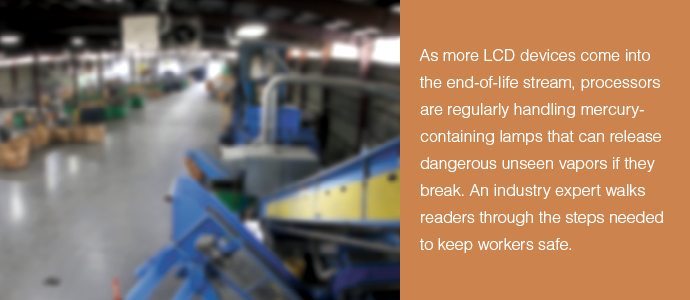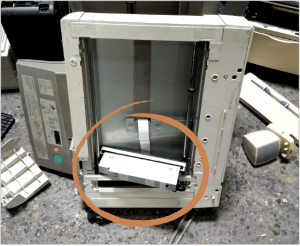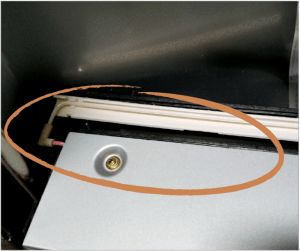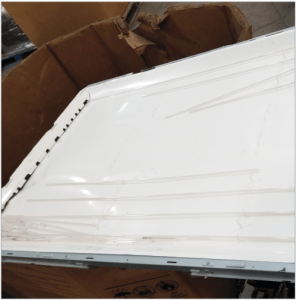
This article originally appeared in the December 2017 issue of E-Scrap News. Subscribe today for access to all print content.
E-scrap stakeholders may be ever so slowly making their way through the North American CRT waste stream, but another toxic-bearing material type has emerged. LCDs (liquid crystal displays), many of which contain mercury lamps, are increasingly showing up at the docks of processors.
Poor housekeeping in managing the lead dust from CRTs was an industry problem, but the issue had a visible indicator: the dust itself. Unfortunately, the mercury vapor from LCD lamps is invisible. So e-scrap processors may not know they have a mercury exposure problem.
By understanding the issue and taking key steps to minimize broken lamps, operators can protect their companies and their workers from this unseen but important danger.
Recognizing the hazard
A typical mercury-bearing lamp is composed of a phosphor-coated glass tube with electrodes at the ends. Inside the lamp is a small amount of mercury and an inert gas, typically argon, under very low pressure.
When an electrical charge is applied, the electrodes energize the mercury vapor, causing it to emit ultraviolet (UV) energy. The phosphor coating absorbs the UV energy, causing the phosphor to fluoresce and emit visible light.
The first step in controlling mercury exposures is to recognize the e-scrap that may contain components with mercury-containing lamps (some people may refer to these as tubes or bulbs).

Older all-in-one printer/fax/scanning machines often contain mercury. The component circled houses a lamp with mercury inside it. These lamps should be carefully removed.
Older style all-in-one printer/fax/scanner machines often use the items. But flat-panel LCDs are likely the bigger threat for most industry operations. These will contain anywhere from one to over 20 lamps per flat-panel screen.
It’s important to know that many newer flat-panel products use LED (light emitting diode) technology, which does not contain mercury. Operators must therefore develop a strong understanding of which LCD models need attention on the mercury front.
In addition, mercury may show up in a variety of e-scrap odds and ends, such as blood pressure cuffs, thermometers, thermostats, batteries, switches, flow meters, valves, rectifiers, fluorescent lightbulbs and more. For companies handling these materials, managers should have a clear understanding of which products require precaution.
Serious short- and long-term health effects
Why are proper procedures so important when it comes to mercury-bearing devices? In short, the health repercussions from exposure are significant.
Mercury can cause serious health effects in workers at high concentrations. Some of the short-term, or acute, symptoms include abdominal pain, nausea, vomiting and diarrhea. Longer-term health effects include kidney damage, muscle tremors and spasms, and impacts to the nervous system that can lead to depression, irritability and nervousness. The term “mad as a hatter” has its roots in the fact that mercury was used in the process to turn furs into felt hats.

A closer look at a mercury-containing lamp inside an all-in-one printer device.
However, dangerous mercury concentrations are typically not found when e-scrap processors are handling materials properly. The trouble arises mainly when mercury-containing tubes break. It’s inevitable breakage will occur from time to time – the key is to immediately place the broken tubes into a closed sealed container. The slow evaporation rate of mercury can be used to help reduce worker exposures.
Also, mercury evaporation from a lamp is highly dependent on the temperature in the disassembly area.
Air monitoring surveys have shown higher levels of mercury during the summer months than during winter in an operation where all else remains the same.
How much exposure is too much? If one lamp breaks, it’s not a problem. If dozens of lamps break, it can result in workers potentially being overexposed to mercury.
A recent study conducted at Linköping University in Sweden indicated that if more than approximately 10 mercury-containing lamps are broken inside a 1-cubic-foot space, the U.S. Occupational Safety and Health Administration (OSHA) permissible exposure limit for mercury would be exceeded inside that space.
The current OSHA permissible exposure limit for inorganic mercury is 100 micrograms per cubic meter (a microgram is one-millionth of a gram). However, this level was established in the 1970s and may not be fully protective of workers today. In fact, the National Institute of Occupational Safety and Health (NIOSH) recommends a level that is half of the current OSHA limit, or 50 micrograms per cubic meter.
Due to the toxicity of mercury, e-scrap processors should strive to reduce worker’s exposures to mercury below this NIOSH limit.
Integrating best practices into procedures
The key to proper mercury management is ensuring the element remains contained. A review of a facility’s entire e-scrap management process, from collection to disassembly, for mercury-containing devices should be conducted. The underlying best practice in the handling of material is simple: Don’t break the lamps. But while understanding this is easy, sometimes it’s difficult to accomplish.
LCD units must be disassembled with care. This requires fine motor skills, and workers should not only be selected for this ability, but should also be encouraged to go slow during processing. This precaution requires continual training and management oversight.
When it comes to specific steps on worker training, OSHA recommends covering the following subjects:
- A clear explanation of the operations and e-scrap equipment that may contain mercury.
- The safe work practices for handling, removal, storage and disposal of the mercury-containing items.
- Signs and symptoms of mercury overexposure.
- Personal hygiene, explaining that mercury can be ingested from hand-to-mouth contact.
- Proper housekeeping work practices to minimize mercury exposures.
- The written procedures and hazard information related to safely handling mercury containing items.
Worker management and supervision for LCD disassembly operations should differ from what is employed for other e-scrap disassembly operations, such as CRT work. Workers who use brute force to disassemble CRT monitors are typically not the best workers for the LCD task.
In addition, managers should be certain to review the facility’s system of pay incentives, piece work or weight-based production incentives. These may need to be adjusted to ensure LCD disassembly workers are taking the precautions needed to prevent breaking lamps during disassembly.
Once mercury-containing lamps are safely removed intact, they should be placed in a shipping container. This container must be selected to handle the long tubes that are characteristic of LCD units.
The key is to ensure workers do not break the lamps when inserting them into the containers and ensuring new containers are provided for workers to use as they are filled.
If any lamps are broken, immediately place them into a sealed and properly labeled container. Sweep up and place all pieces of the broken lamps into this container. Mercury vapors will continue to evaporate from the broken tubes for hours or days, depending on temperature and other factors. Keeping these mercury vapors inside a sealed container is the key.
If the lid is left off the broken lamp storage container, the mercury vapors will continue to become airborne, potentially exposing workers in the area.
Tools to keep tabs on levels
Since the presence of mercury is not visible, air monitoring is critical to help identify the effectiveness of disassembly work practices.
Air monitoring can be performed using direct reading instruments. These tools sample the air and provide a measurement of the mercury concentration present. Reliable instruments in this category typically cost several thousand dollars.
However, there are other lower cost methods, including a type of product known as a direct reading colorimetric tube. These products are used with a hand-operated pump – the media in the tube changes color if mercury is detected in the area.

This is an example of an LCD device with multiple mercury lamps that has been improperly handled, resulting in broken lamps and the release of dangerous vapor.
Further, facilities can invest in safeguards such as passive monitors and small air sampling pumps and tubes, which are clipped on the upper bodies of workers. These instruments sample the air that workers are breathing. After an entire shift or a few hours, the badge or tube is sent to an analytical laboratory and the concentration of mercury in the air can be calculated.
Any of these mercury air-sampling methods will work sufficiently. The key is to ensure mercury monitoring is a regular component of a plant’s overall mercury management program. The mercury concentration in the air will determine if the current disassembly and mercury management work practices are effectively controlling workers’ exposures.
Another possible step is to assess mercury levels in workers by testing urine or blood. Urine is the preferred method of biological monitoring because mercury can bio-accumulate in the blood stream.
Urine and blood monitoring requires workers to be tested at a clinic or other health care provider and is not frequently performed by e-scrap disassembly processors.
Finally, e-scrap processors need to understand the critical difference between lead and mercury when it comes to ventilation.
Lead dust can be captured by using high efficiency particulate air (HEPA) filters. Mercury vapor cannot be controlled this way, and using a HEPA vacuum or HEPA dust collection system will only spread the mercury throughout the building. Mercury can be captured using a specially treated charcoal filter on a vapor collection system. However, this is an expensive option and most e-scrap processors would be better suited to properly managing the mercury lamps versus trying to control the mercury vapor after it is released into the workplace.
Refine and remind
To recap, a number of procedural steps can be followed to make facilities safer when it comes to mercury control.
Review your workflow to ensure LCDs and all-in-one printers are being safely handled and disassembled to prevent breakage of mercury-containing lamps. Also, be sure all broken lamps are immediately placed into sealed containers for later shipment to retort or hazardous waste management facilities.
In addition, it’s important to perform air monitoring to determine if current work practices are effective in controlling workers’ exposure to mercury. If not, determine what improvements are needed to better manage the process.
And through all training and discussion, make it clear again and again to employees that the goal is to avoid breaking the lamps.
Lloyd Andrew, CIH, CSP, is president of EnvirOSH Services, a Texas-based consultancy offering environmental, health and safety services. He can be contacted at [email protected].

